EUROPEAN ORGANIZATION FOR NUCLEAR RESEARCH ASearchfor ! Oscillation The CHORUS Collabor
欧洲核研究组织60年
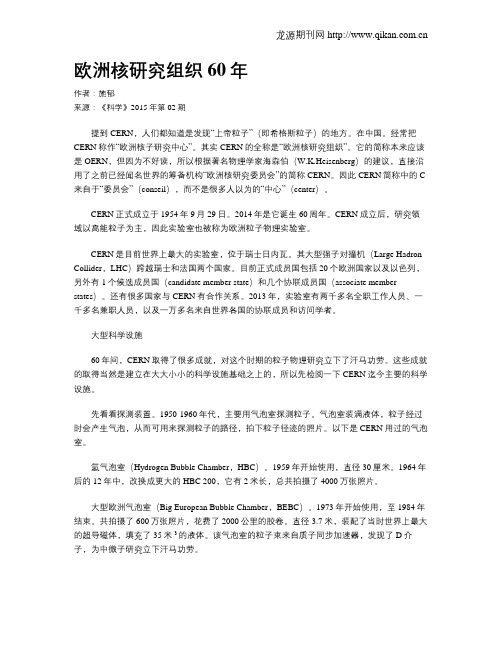
欧洲核研究组织60年作者:施郁来源:《科学》2015年第02期提到CERN,人们都知道是发现“上帝粒子”(即希格斯粒子)的地方。
在中国。
经常把CERN称作“欧洲核子研究中心”。
其实CERN的全称是“欧洲核研究组织”。
它的简称本来应该是OERN,但因为不好读,所以根据著名物理学家海森伯(W.K.Heisenberg)的建议,直接沿用了之前已经闻名世界的筹备机构“欧洲核研究委员会”的简称CERN。
因此CERN简称中的C 来自于“委员会”(conseil),而不是很多人以为的“中心”(center)。
CERN正式成立于1954年9月29日。
2014年是它诞生60周年。
CERN成立后,研究领域以高能粒子为主,因此实验室也被称为欧洲粒子物理实验室。
CERN是目前世界上最大的实验室,位于瑞士日内瓦。
其大型强子对撞机(Large Hadron Collider,LHC)跨越瑞士和法国两个国家。
目前正式成员国包括20个欧洲国家以及以色列,另外有1个候选成员国(candidate member state)和几个协联成员国(associate member states)。
还有很多国家与CERN有合作关系。
2013年,实验室有两千多名全职工作人员、一千多名兼职人员,以及一万多名来自世界各国的协联成员和访问学者。
大型科学设施60年间,CERN取得了很多成就,对这个时期的粒子物理研究立下了汗马功劳。
这些成就的取得当然是建立在大大小小的科学设施基础之上的,所以先检阅一下CERN迄今主要的科学设施。
先看看探测装置。
1950-1960年代,主要用气泡室探测粒子。
气泡室装满液体,粒子经过时会产生气泡,从而可用来探测粒子的路径,拍下粒子径迹的照片。
以下是CERN用过的气泡室。
氢气泡室(Hydrogen Bubble Chamber,HBC)。
1959年开始使用,直径30厘米。
1964年后的12年中,改换成更大的HBC 200,它有2米长,总共拍摄了4000万张照片。
欧洲原子核能研究组织CERN介绍

欧洲核子研究组织的大楼
CERN is the bigest physics laboratory in the world,WWW also orginates there.
粒子物理学博物馆
欧洲核子研究组织
• At CERN, the European Organization for Nuclear Research, physicists and engineers are probing the fundamental structure of the universe. They use the world's largest and most complex scientific instruments to study the basic constituents of matter - the fundamental particles. • 在CERN,欧洲核研究组织,物理学家和工 程师探查宇宙的根本结构。他们使用最大 世界的和多数复杂科学仪表学习问题基本ded in 1954, the CERN laboratory sits astride跨着 the Franco-Swiss border near Geneva. It was one of Europe's first joint ventures and now has 20 member states. 企业
This is physics museum.
These are member states.
sign
celebrate 50th birthday working space
european joumnal of organie chemistry类别
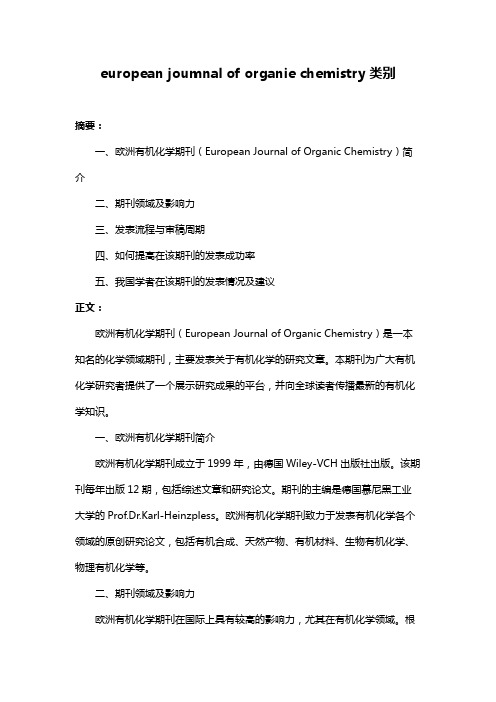
european joumnal of organie chemistry类别摘要:一、欧洲有机化学期刊(European Journal of Organic Chemistry)简介二、期刊领域及影响力三、发表流程与审稿周期四、如何提高在该期刊的发表成功率五、我国学者在该期刊的发表情况及建议正文:欧洲有机化学期刊(European Journal of Organic Chemistry)是一本知名的化学领域期刊,主要发表关于有机化学的研究文章。
本期刊为广大有机化学研究者提供了一个展示研究成果的平台,并向全球读者传播最新的有机化学知识。
一、欧洲有机化学期刊简介欧洲有机化学期刊成立于1999年,由德国Wiley-VCH出版社出版。
该期刊每年出版12期,包括综述文章和研究论文。
期刊的主编是德国慕尼黑工业大学的Prof.Dr.Karl-Heinzpless。
欧洲有机化学期刊致力于发表有机化学各个领域的原创研究论文,包括有机合成、天然产物、有机材料、生物有机化学、物理有机化学等。
二、期刊领域及影响力欧洲有机化学期刊在国际上具有较高的影响力,尤其在有机化学领域。
根据Web of Science的数据,该期刊的最新影响因子(2020年)为2.844,排名位居有机化学领域期刊的前列。
欧洲有机化学期刊的文章被广泛关注,为全球研究者提供了丰富的学术资源。
三、发表流程与审稿周期欧洲有机化学期刊的审稿周期较快,通常在3-4个月内完成。
投稿后,编辑会对文章进行初步筛选,然后送至相关领域的专家进行审稿。
审稿人将对文章的质量、创新性、研究方法等方面进行评估,并给出审稿意见。
根据审稿意见,编辑将决定是否接受稿件。
若稿件被接受,出版周期较快,一般在2-3个月内出版。
四、如何提高在该期刊的发表成功率1.选择合适的主题:研究内容应具有创新性和学术价值,符合期刊的发表要求。
2.严谨的实验和数据分析:确保实验设计合理,数据准确可靠。
参与欧洲核子中心国际合作的成效 体会 启示
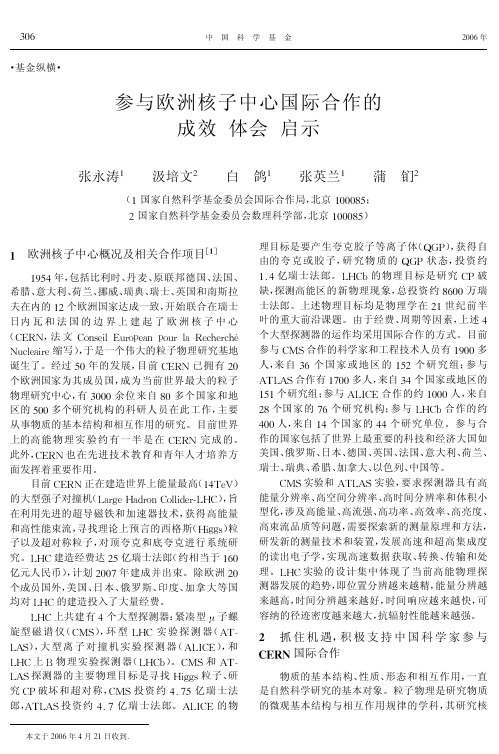
理目标是要产生夸克胶子等离子体 (K ) , 获得自 L J 投资约 由的 夸 克 或 胶 子, 研究物质的 K L J 状 态, 亿瑞士法郎。 的物理目标是研究 % & $ > @ * I * J破 缺, 探测高能区的新物理现象, 总投资约 ’ # " " 万瑞 士法郎。上述物理目标均是物理学在 ! % 世纪前半 叶的重大前沿课题。由于经费、 周期等因素, 上述 $ 个大型探测器的运作均采用国际合作的方式。目前 参与 * D E合作的科学家和工程技术人员有 % ) " "多 人, 来自; 参与 #个国家或地区的% ( ! 个 研 究 组; 来自; F < > F E合作有% C " "多人, $ 个国家或地区的 个研究组; 参与 合作的约 来自 % ( % F > G * + % " " " 人, 参与 > ! ’个国家的 C # 个研究机构; @ * I 合作的约 来自 % $ " "人, $ 个国家的 $ $ 个研究单位。参与合 作的国家包括了世界上最重要的科技和经济大国如 美国、 俄罗斯、 日本、 德国、 英国、 法国、 意大利、 荷兰、 瑞士、 瑞典、 希腊、 加拿大、 以色列、 中国等。 要求探测器具有高 * D E实验和 F < > F E 实验, 能量分辨率、 高空间分辨率、 高时间分辨率和体积小 型化, 涉及高能量、 高流强、 高功率、 高效率、 高亮度、 高束流品质等问题, 需要探索新的测量原理和方法, 研发新的测量技术和装置, 发展高速和超高集成度 的读出电子学, 实现高速数据获取、 转换、 传输和处 理。> 实验的设计集中体现了当前高能物理探 @ * 测器发展的趋势, 即位置分辨越来越精, 能量分辨越 来越高, 时间分辨越来越好, 时间响应越来越快, 可 容纳的径迹密度越来越大, 抗辐射性能越来越强。
和平利用核能协定 英文版
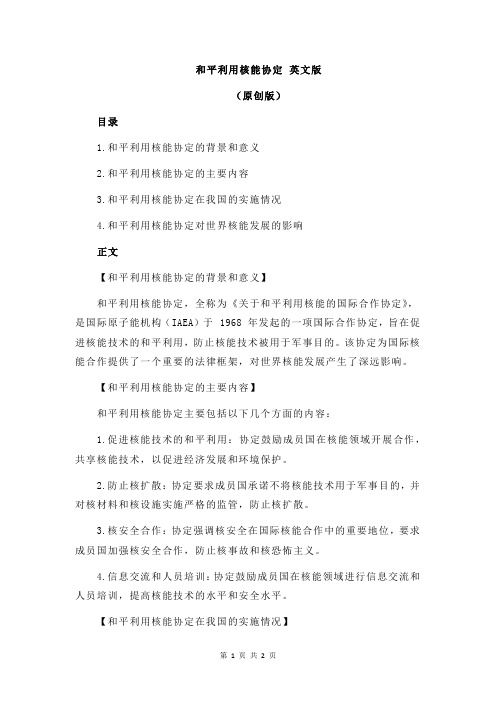
和平利用核能协定英文版(原创版)目录1.和平利用核能协定的背景和意义2.和平利用核能协定的主要内容3.和平利用核能协定在我国的实施情况4.和平利用核能协定对世界核能发展的影响正文【和平利用核能协定的背景和意义】和平利用核能协定,全称为《关于和平利用核能的国际合作协定》,是国际原子能机构(IAEA)于 1968 年发起的一项国际合作协定,旨在促进核能技术的和平利用,防止核能技术被用于军事目的。
该协定为国际核能合作提供了一个重要的法律框架,对世界核能发展产生了深远影响。
【和平利用核能协定的主要内容】和平利用核能协定主要包括以下几个方面的内容:1.促进核能技术的和平利用:协定鼓励成员国在核能领域开展合作,共享核能技术,以促进经济发展和环境保护。
2.防止核扩散:协定要求成员国承诺不将核能技术用于军事目的,并对核材料和核设施实施严格的监管,防止核扩散。
3.核安全合作:协定强调核安全在国际核能合作中的重要地位,要求成员国加强核安全合作,防止核事故和核恐怖主义。
4.信息交流和人员培训:协定鼓励成员国在核能领域进行信息交流和人员培训,提高核能技术的水平和安全水平。
【和平利用核能协定在我国的实施情况】我国于 1984 年加入和平利用核能协定,一直秉持合作、共赢的原则,积极参与国际核能合作。
在过去的几十年里,我国在核能领域的研究和应用取得了举世瞩目的成就,不仅在核能发电、核燃料循环等方面取得了突破,而且在核安全、核应急等方面积累了丰富的经验。
同时,我国还与其他成员国分享核能技术,为世界核能发展做出了积极贡献。
【和平利用核能协定对世界核能发展的影响】和平利用核能协定对世界核能发展产生了深远影响,主要表现在以下几个方面:1.促进了核能技术的传播和应用:协定鼓励成员国在核能领域开展合作,使得核能技术得以在全球范围内传播和应用,为世界经济发展和能源安全提供了有力支持。
2.遏制了核扩散:协定对核材料和核设施实施严格的监管,有效地遏制了核扩散,维护了国际和平与安全。
欧洲核研究组织60年
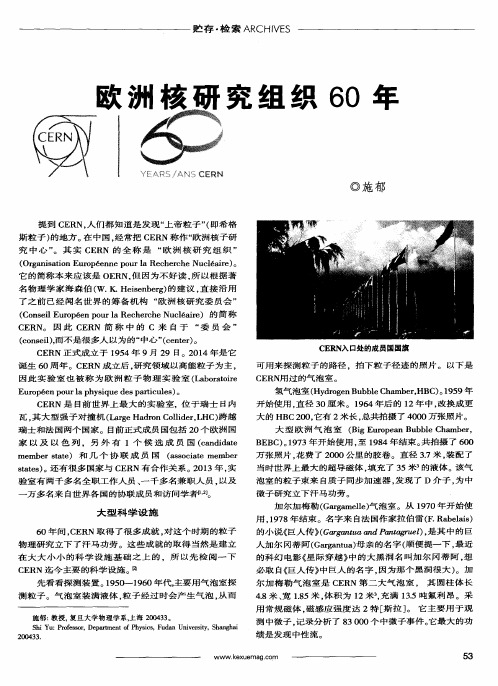
万 多名 来 自世 界 各 国 的协 联 成 员 和 访 问 学 者 】 。
大型 科 这 个 时 期 的粒 子
用. 1 9 7 8年 结 束 。名 字 来 自法 国作 家拉 伯
的小 说 《 巨人 传 ) ( G  ̄g a n t u a a n dP nt a a g r u e
人加尔 冈蒂阿( Ga r g a n t u a ) 母 亲的名字( 顺一 的科 幻 电影 《 星 际穿越》 中 的 大 黑 洞 名 叫j
物 理 研 究 立 下 了 汗 马 功 劳 。这 些 成 就 的取 得 当 然 是 建 立
在 大 大 小 小 的 科 学 设 施 基 础 之 上 的 ,所 以 先 检 阅 一 下
CE RN 是 目前 世 界 上 最 大 的 实 验 室 ,位 于 瑞 士 日内 瓦, 其大型强子对撞 机 (  ̄r g e Ha d r o n Co l l i d e r , L HC) 跨越 瑞 士 和法 国两 个 国家 。目前 正式 成 员 国包 括 2 0个 欧 洲 国 家 以 及 以 色 列 ,另 外 有 1个 候 选 成 员 国 ( c a n d i d a t e
( Or g a n i s a t i o n E u r o p 6 e n n e p o u r l a Re c h e r c h e Nu c l 6 a i r e ) 。
它 的 简 称 本 来 应 该 是 OERN, 但 因 为不 好 读 , 所 以根 据 著 名物理 学家海森伯 ( W. I < . He i s e n b e r g ) 的建议 , 直接沿用
贮存 ・ 检索 A R CHI V E S
欧
V{ _ = I ARS / ANq C黩鞍
“人造太阳”计划

“人造太阳”计划作者:徐翘楚来源:《百科知识》2011年第01期看过灾难大片《2012》的人们可能还记得,影片里有一个庞大的、多国合作完成的“诺亚方舟”计划,它承载着人类继续繁衍生存的希望。
目前,国际间进行研究合作,共同建设的“人造太阳”国际热核聚变实验堆,它承载的是人类未来新能源的希望。
1985年,处在冷战时期的美、苏两个核超级大国在日内瓦峰会上就提出了一个人类历史上前所未有的宏大合作计划——“国际热核聚变实验堆计划”,它被称作“伊特尔”人造太阳计划。
1988年,该计划正式启动。
经过20多年的共同努力,在克服一个又一个重大科研难题的基础上,由中、欧、日、韩、俄、美六方组成的ITER国际组织于2007年10月24日正式成立,后来印度也加入进来。
2010年11月,被称为“人造太阳”的美国国家点火装置(MF)完成了首次综合点火实验:192束激光系统使中心最高温度达到华氏600万度,相当于恒星或大行星核心的温度。
虽然据说这次实验没有达到预期目标,但科学家依然对NIF的未来充满信心。
“人造太阳”的科学原理我们所说的“人造太阳”就是把美国研制的192条激光束集中在一个像花生米大小的装有重氢燃料的目标上,然后把这个燃料加热到一亿摄氏度,并且施加足够的压力,让重氢核发生剧变反应,从而模拟出这种跟太阳内部差不多的温度和压力,这个聚变不是核裂变,它的好处在于副产品当中没有放射性的物质,而且它的燃料来源也比较容易获取。
实际“人造太阳”就是模仿太阳上时刻都在发生的核聚变。
核聚变就是两个原子核相聚、碰撞,结合成一个新的原子核的过程。
1938年,德国科学家推测太阳能源可能来自它的内部氢核聚变成氦核的热核反应,这甚至早于核裂变模型的提出。
然而,与能够在室温下进行的裂变不同,聚变发生需要巨大能量。
这是因为当两个带正电的氢原子核靠近的时候,根据“同性相斥”的原理,相互间的斥力将阻碍聚变的发生。
要克服这种阻碍,只有两种途径:强大的引力或上亿度的高温。
物理欧洲核子研究组织
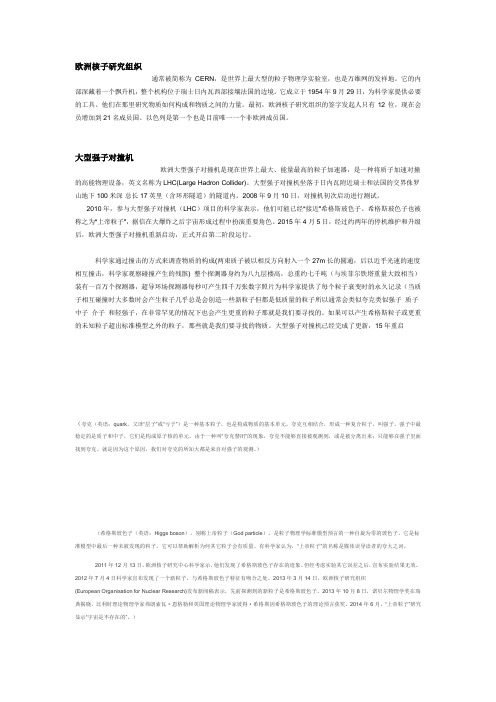
欧洲核子研究组织通常被简称为CERN,是世界上最大型的粒子物理学实验室,也是万维网的发祥地。
它的内部深藏着一个飘升机,整个机构位于瑞士日内瓦西部接壤法国的边境。
它成立于1954年9月29日,为科学家提供必要的工具。
他们在那里研究物质如何构成和物质之间的力量。
最初,欧洲核子研究组织的签字发起人只有12位,现在会员增加到21名成员国。
以色列是第一个也是目前唯一一个非欧洲成员国。
大型强子对撞机欧洲大型强子对撞机是现在世界上最大、能量最高的粒子加速器,是一种将质子加速对撞的高能物理设备,英文名称为LHC(Large Hadron Collider)。
大型强子对撞机坐落于日内瓦附近瑞士和法国的交界侏罗山地下100米深·总长17英里(含环形隧道)的隧道内。
2008年9月10日,对撞机初次启动进行测试。
2010年,参与大型强子对撞机(LHC)项目的科学家表示,他们可能已经“接近”希格斯玻色子。
希格斯玻色子也被称之为“上帝粒子”,据信在大爆炸之后宇宙形成过程中扮演重要角色。
2015年4月5日,经过约两年的停机维护和升级后,欧洲大型强子对撞机重新启动,正式开启第二阶段运行。
科学家通过撞击的方式来调查物质的构成(两束质子被以相反方向射入一个27m长的圆通,后以近乎光速的速度相互撞击,科学家观察碰撞产生的残骸) 整个探测器身约为八九层楼高,总重约七千吨(与埃菲尔铁塔重量大致相当)装有一百万个探测器,超导环场探测器每秒可产生四千万张数字照片为科学家提供了每个粒子衰变时的永久记录(当质子相互碰撞时大多数时会产生粒子几乎总是会创造一些新粒子但都是低质量的粒子所以通常会类似夸克类似强子质子中子介子和轻强子,在非常罕见的情况下也会产生更重的粒子那就是我们要寻找的。
如果可以产生希格斯粒子或更重的未知粒子超出标准模型之外的粒子,那些就是我们要寻找的物质。
大型强子对撞机已经完成了更新,15年重启(夸克(英语:quark,又译“层子”或“亏子”)是一种基本粒子,也是构成物质的基本单元。
欧洲核子研究中心的介绍
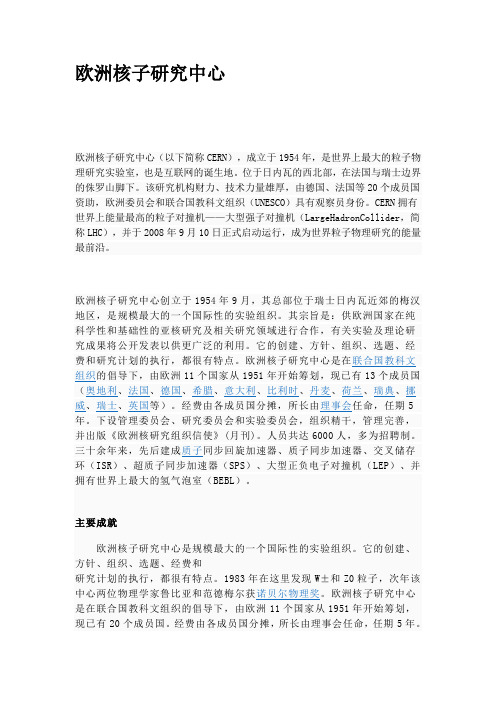
欧洲核子研究中心欧洲核子研究中心(以下简称CERN),成立于1954年,是世界上最大的粒子物理研究实验室,也是互联网的诞生地。
位于日内瓦的西北部,在法国与瑞士边界的侏罗山脚下。
该研究机构财力、技术力量雄厚,由德国、法国等20个成员国资助,欧洲委员会和联合国教科文组织(UNESCO)具有观察员身份。
CERN拥有世界上能量最高的粒子对撞机——大型强子对撞机(LargeHadronCollider,简称LHC),并于2008年9月10日正式启动运行,成为世界粒子物理研究的能量最前沿。
下设管理委员会、研究委员会和实验委员会,组织精干,管理完善。
人员共达6000人,多为招聘制。
30余年来,先后建成质子同步回旋加速器、质子同步加速器、交叉储存环(ISR)、超质子同步加速器(SPS)、大型正负电子对撞机(LEP)、并拥有世界上最大的氢气泡室(BEBL)。
欧洲核子研究中心作为国际性实验机构,拥有雄厚的财力、物力和技术力量。
由于工作涉及许多国家和组织,在建设和研究中难免会出现种种矛盾和磨擦,但经过协商和合作,工作进行顺利,庞大计划都能按时兑现,接连不断取得举世瞩目的成就。
欧洲核子研究中心作为国际性实验机构,拥有雄厚的财力、物力和技术力量。
由于工作涉及许多国家和组织,在建设和研究中难免会出现种种矛盾和摩擦,但经过协商和合作,工作进行顺利,庞大计划都能按时兑现,接连不断取得举世瞩目的成就。
CERN需要把世界上最大,功能最强的粒子加速器连接到世界上最大的科学计算网格中的600台电脑上。
CERN也希望ProCurve能够为其提供ProCurve适应性边缘架构战略,包括600台ProCurve3400cl交换机和400台屡获殊荣的ProCurve3500yl交换机。
CERN的研究计划由来自80多个国家/地区的6500名研究人员实施(相当于世界粒子物理学家总数的一半左右),并由2500名常驻员工提供支持。
CERN的研究成果包括W和Z玻色子(宇宙的两种基本粒子)的发现。
基于Geant4_的核孔膜生产模拟研究

第38卷第1期2024年2月南华大学学报(自然科学版)Journal of University of South China(Science and Technology)Vol.38No.1Feb.2024收稿日期:2023-09-05基金项目:厦门市青年创新基金资助项目(3502Z20206025)作者简介:张倩影(1990 ),女,工程师,硕士,主要从事核技术应用㊁城市安全评价方面的研究㊂E-mail:skrvvtg@㊂∗通信作者:傅楗强(1990 ),男,助理研究员,博士,主要从事辐射物理与探测技术方面的研究㊂E-mail:fujq12@DOI :10.19431/ki.1673-0062.2024.01.012基于Geant4的核孔膜生产模拟研究张倩影,傅楗强∗(清华海峡研究院(厦门),福建厦门361015)摘㊀要:利用核反应堆产生的裂变重离子碎片辐照固体薄膜,是生产核孔膜的主要方式之一㊂为优化反应堆核孔膜生产工艺参数,给核孔膜生产提供理论指导,本文基于Geant4开发了反应堆生产核孔膜的原理性模拟程序,对铀靶在热中子辐照下裂变碎片的生成及出射物理过程开展模拟,并分析计算了不同厚度下铀靶裂变碎片的出射能量㊁角度分布,从理论上优化了核孔膜生产中的铀靶厚度及固体薄膜厚度㊂结果表明,铀靶厚度为4μm 时裂变碎片出射强度最高;受裂变碎片射程的限制,反应堆生产核孔膜所用的固体薄膜的厚度最大约为8μm ㊂关键词:核孔膜;Geant4;蒙特卡洛模拟中图分类号:TL99文献标志码:A文章编号:1673-0062(2024)01-0090-07Geant 4-based Simulation Study of Nuclear Track-etchedMembrane ProductionZHANG Qianying ,FU Jianqiang ∗(Cross-strait Tsinghua Research Institute,Xiamen,Fujian 361015,China)Abstract :One of the main ways to produce nuclear track-etched membrane is irradiating solid membranes with the fission fragments produced by nuclear reactor.In order to opti-mize the production process parameters of nuclear track-etched membranes and provide theoretical guidance for nuclear track-etched membrane production,a simulation program is developed based on Geant4to simulate the process of nuclear track-etched membrane produced by nuclear reactor.The physical process of generation and emission of neutron-induced Uranium 235fission fragments are studied,and the energy and angular distribu-tions of fission fragments under different thicknesses of the target are analyzed and calculat-ed.The thickness of the Uranium target and solid membrane are optimized theoretically.It9第38卷第1期张倩影等:基于Geant4的核孔膜生产模拟研究2024年2月can be concluded that a4μm thick Uranium target has the highest emission intensity offission fragments.The maximum thickness of the solid membranes is about8μm,which islimited by the range of fission fragments.key words:nuclear track-etched membrane;Geant4;Monte Carlo simulation0㊀引㊀言核孔膜是利用反应堆或加速器产生的重离子辐照绝缘固体薄膜,后经化学蚀刻,在薄膜中生成纳米至微米级的穿透性微孔[1]㊂核孔膜具有表面坚实光滑㊁孔形规则㊁孔径均一等特性,在医药精密过滤㊁精细化工㊁生化分析㊁电池隔膜㊁微量探测等高端领域均有重要应用价值[2-4]㊂重离子辐照固体薄膜是核孔膜生产中的关键环节㊂国内外许多机构已开展加速器生产核孔膜的物理仿真工作[5-6],对影响核孔膜性能的加速器辐照要素进行剖析,进而优化核孔膜生产工艺㊂而针对反应堆生产核孔膜的物理仿真工作,鲜见公开发表文献㊂蒙特卡洛方法是核物理模拟的常用方法[7],本文基于蒙特卡洛程序包Geant4搭建了反应堆生产核孔膜原理性仿真平台,可物理仿真热中子辐照下靶材出射裂变碎片的种类㊁能量㊁角度等数据,及裂变碎片经准直后在固体薄膜中形成潜径迹的过程㊂利用该仿真平台,可对靶材㊁准直器㊁固体薄膜等相关参数开展物理分析及模拟计算,从而优化反应堆生产核孔膜中的物理结构设计和工艺参数㊂1㊀仿真平台设计1.1㊀几何结构模型反应堆生产核孔膜的基本流程可以概括为:热中子与靶材作用,产生裂变碎片;裂变碎片从靶材出射后经准直器准直;准直后的裂变碎片入射固体薄膜,与薄膜基材发生作用形成潜径迹;化学蚀刻潜径迹生成微孔㊂参考生产中的真实结构[8],本文构建了简化的几何结构模型,如图1所示包括中子源㊁靶件㊁准直器㊁固体薄膜四部分㊂1)中子源:反应堆堆芯核裂变产生的快中子,通过慢化技术慢化为热中子㊂本文模拟中将中子源简化为能量分布满足麦克斯韦分布的热中子,入射方向垂直于靶件所在平面㊂2)靶件:靶件为平面结构,常见的靶基材为铝㊂靶材通常为中子诱发可核裂变材料㊂裂变材料镀在200μm厚的铝基材上,镀层的厚度通常为微米量级㊂靶材的材料和厚度均可在程序中设置㊂本文模拟中,靶材材料固定为铀235丰度为90%的金属铀,厚度可调节㊂图1㊀模拟采用的几何结构模型图Fig.1㊀The geometric structure model used inthe simulation3)准直器:由于出射裂变碎片的角度分布具有随机性,生产中通常利用准直器对出射裂变碎片进行角度筛选㊂仿真平台通过设置不同的准直器结构,可对出射裂变碎片进行角度筛选,从而得到不同准直角度下出射裂变碎片的物理数据㊂本文的研究重点在于靶材裂变反应和出射过程的模拟,暂未开展准直器的优化研究工作㊂本文模拟中采用固定结构的准直器,可筛选出射角小于40ʎ的裂变碎片(出射角的定义为:碎片出射方向与靶件平面法线的夹角)㊂4)固体薄膜:常用于制备核孔膜的膜材料有聚对苯二甲酸乙二醇酸(polyethy-lene terephthalate, PET)㊁聚碳酸酯(polycarbonate,PC)等薄膜,厚度从数微米到数十微米不等㊂固体薄膜的基材材料和厚度均可在程序中设置㊂本文模拟中固体薄膜材料采用聚酯材料,化学式为C10H8O4,密度为1.40g/cm3㊂1.2㊀Geant4程序开发本文采用国际通用的成熟开源软件Geant4 (GEometry ANd Tracking4几何与跟踪程序第419第38卷第1期南华大学学报(自然科学版)2024年2月版)对上述过程进行模拟㊂Geant4是由欧洲核子研究组织(European Organization for Nuclear Re-search,简称CERN)开发的专门模拟粒子与物质相互作用的C++开源蒙特卡洛程序包[9]㊂用户可以根据需求自由更改㊁扩充程序㊂Geant4模拟的准确性已被广大科研人员所认可,被广泛的运用在高能物理㊁天文学㊁核医学㊁国土安全等领域㊂本文的模拟工作,程序运行版本为Geant4.10.06㊂1.2.1㊀粒子源设置Geant4中初级事件的生成主要是使用粒子发生器来完成㊂本文模拟使用G4ParticleGun作为粒子发生器,通过G4ParticleGun类,可以定义中子源的发射方向㊁位置㊁能量,从而模拟实际的中子源分布㊂本文模拟中将中子源简化为单一入射方向,能量分布满足麦克斯韦分布的热中子束流,最可几能量为0.0253eV㊂1.2.2㊀物理列表和环境变量设置物理列表和环境变量设置是本文仿真平台开发中的难点㊂物理过程主要描述粒子如何与物质发生相互作用㊂在本文模拟中,热中子与靶材作用发生核反应,进而生成裂变碎片是关键物理过程,为此需在程序中加入相关核裂变物理过程㊂Geant4中对物理过程和粒子的定义主要在Phys-icsList类中进行㊂本文的模拟从Geant4已有的PhysicsList中选择满足中子输运物理过程的列表,并通过相关设置激活裂变碎片的模拟㊂热中子诱发靶材裂变,需要模拟详细的中子输运过程㊂Geant4中可使用NeutronHP程序包(high precision neutron package)来模拟20MeV以下的低能中子反应㊂物理表QGSP_BIC_HP包含了NeutronHP模型,因此在主程序中将PhysicsList 设置为QGSP_BIC_HP㊂针对裂变碎片生成的模拟,B.Wendt开发了一种新的裂变事件模型,命名为裂片碎片生成器FFG(fission fragment generator)[10]㊂FFG可准确地模拟裂变事件,包括裂变碎片的质量和能量等参数㊂FFG已被集成到Geant410.0以上的版本,使用FFG需启用WENDT_FISSION_MODEL㊂裂片碎片生成的产额分布调用了G4NDL4.6/ Fission/FF中的相关截面数据,运行前需确保Geant4的数据库中已下载了G4NDL4.6库㊂由于Geant4的缺省设置里关闭了裂变碎片的生成过程,需要通过环境变量的配置来开启裂变碎片的模拟㊂在QGSP_BIC_HP物理表的基础上,将系统环境变量G4NEUTRONHP_PRODUCE_FISSION_FRAGMENTS和G4NEUTRON_HP_USE_ WENDT_FISSION_MODEL设置为YES㊂通过以上设置,仿真平台方可模拟核裂变并生成裂变碎片㊂物理过程中对反应步长的配置见下一小节㊂1.2.3㊀反应步长设置靶材和固体薄膜的厚度通常在微米量级㊂为了精确记录裂变碎片的运动轨迹,需对Geant4运行中Step的最大步长进行设置㊂设置方法为在文件中,对靶材和固体薄膜对应的逻辑体配置SetUserLimits();在主文件中,对物理列表PhysicsList调用RegisterPhysics (new G4StepLimiterPhysics())命令㊂本文的模拟中,最大步长设置为0.01μm㊂1.2.4㊀数据存储设置Geant4详细地模拟了每个事例中生成各个次级粒子输运过程中的动量㊁能量㊁时间及位置坐标信息㊂本文聚焦裂变碎片的运动径迹和能量沉积过程,在文件中,编写输出文件,将每个事例中裂变碎片Track的详细数据,写入二进制格式文件,用于后续的统计分析㊂2㊀计算结果与讨论2.1㊀初始裂变碎片的统计分析初始裂变碎片是指热中子辐照下铀235靶核发生裂变反应,生成的两个重离子碎片㊂不同厚度的铀靶,生成的初始裂变碎片在理论上具有相同的统计特性,本文以靶材厚度1μm的数据为例进行统计分析㊂图2给出了热中子辐照下铀235靶核发生核裂变,生成的初始裂变碎片按动能和质量数分布的二维散点图,图中分布呈两个明显束团㊂图2㊀裂变碎片按能量与质量数分布的二维散点图Fig.2㊀The scatter plot of fission fragmentsdistribution according to energy and mass29第38卷第1期张倩影等:基于Geant4的核孔膜生产模拟研究2024年2月图3给出了初始裂变碎片按照质量数和能量的裂变产额㊂裂变碎片的质量分布形成双峰,在幻数(A ~132)及其互补(A ~102)碎片附近的核素产额高于其他核素㊂裂变碎片动能主要分布在50~120MeV 的范围内,且明显成两个能带分布,轻碎片的动能高于重碎片的动能,服从动量守恒定律㊂每个碎片的初始动能对应约107m /s 的速度量级㊂图3㊀铀235按裂变碎片质量数的裂变产额和按能量的裂变产额Fig.3㊀The fission yield of U235as a function of product fragments mass number and product fragments energy㊀㊀以铀靶所在平面为XY 平面,铀靶的法线为Z轴,统计初始裂变碎片的出射方向㊂统计结果显示,初始碎片的出射方向为4π立体角内的均匀出射㊂2.2㊀靶材厚度的影响本文模拟中设置了不同的靶材厚度,以此探究不同靶材厚度下出射裂变碎片物理参数的变化㊂2.2.1㊀靶厚对出射强度影响中子通量一定的情况下,铀靶厚度越大,与热中子作用发生裂变的概率越大,产生的初始裂变碎片越多㊂但随着铀靶厚度的增大,裂变碎片从铀靶出射的几率随之减小㊂对不同靶材厚度,模拟计算靶核裂变概率(裂变事例与入射中子数之比)㊁表面出射概率(出射裂变碎片与裂变事例之比),绘制曲线如图4所示㊂从图4中可以看出,靶核裂变概率与靶材厚度成正比增加,表面出射概率随靶材厚度增加逐渐减小㊂定义靶核裂变概率与表面出射概率两者的乘积为出射强度系数㊂提高裂变碎片出射强度可减少辐照时间,对核孔膜的生产是有益㊂中子通量一定的情况下,裂变碎片出射强度随着靶材厚度增加而增强并逐渐达到饱和,靶材厚度为4μm 时出射强度系数达到极值,此时继续增加靶材厚度已经没有意义㊂从出射强度系数变化曲线来看,靶材厚度要控制在4μm 以下,这样既能节省靶材,又能保证较高的裂变碎片出射强度㊂图4㊀靶核裂变概率㊁表面出射概率以及出射强度系数随靶材厚度的变化曲线Fig.4㊀The variation curve of target fission probability ,surface emission probability and emission intensity coefficient with target thickness2.2.2㊀靶厚对出射能量影响如图5所示,裂变碎片在铀靶的运动径迹长度L 与核裂变发生点在靶材的深度D 和出射角θ关系为L =D cos θ(1)㊀㊀从式(1)可见,初始裂变碎片生成点在铀靶中的深度D 越大,出射角θ越大,则出射前裂变碎片在铀靶内的运动径迹L 越长,损失的能量也越39第38卷第1期南华大学学报(自然科学版)2024年2月大,导致出射裂变碎片的能量降低㊂图5㊀裂变碎片在铀靶中运动轨迹示意图Fig.5㊀The schematic diagram of the trajectory offission fragments in the Uranium target模拟计算了不同靶材厚度下,铀靶表面出射裂变碎片的能量分布情况,如图6所示㊂可见随着铀靶厚度的增加,出射能谱向低能区发生弥散㊂出射能谱的低能弥散现象,意味着出射碎片中有大量低能的粒子,这些粒子在固体薄膜内的射程很短㊂若裂变碎片不能穿透固体薄膜,会引起核孔膜中的 盲孔 ㊂为了评估初始裂变碎片在铀靶中的深度D 和出射角θ两个因素对低能弥散现象的贡献,统计了不同靶材厚度下,裂变碎片从靶材表面出射能量与出射角度的分布散点图㊂从图7中可以看出,靶材厚度非常薄时,出射碎片的能量呈明显的两条能带㊂随着靶材厚度的增加,出射碎片的能量向低能出现弥散,且出射角度越大,弥散越严重㊂图6㊀不同靶材厚度下,裂变碎片从靶材表面出射的能谱图Fig.6㊀The energy spectrums of the emission fissionfragments from the target under differenttargetthicknesses图7㊀不同靶材厚度下,裂变碎片从靶材出射能量与出射角度的二维散点图Fig.7㊀The relationship of the energy and angle of the emission fission fragments fromthe target under different target thicknesses49第38卷第1期张倩影等:基于Geant4的核孔膜生产模拟研究2024年2月㊀㊀低能弥散受靶材厚度和出射角度两个因素叠加的影响㊂尤其是出射角度大于50ʎ时,裂变碎片在质量和能量上的分散性都很大,大量能量低的裂变碎片无法贯穿固体薄膜而形成核孔膜的盲孔㊂从这个角度考虑,为了保障核孔膜的通孔率,一方面靶材的厚度应该适当的薄,另一方面需通过准直器屏蔽出射角度过大的低能粒子㊂2.3㊀准直器的作用从图7的分布图可以看出,低能量的裂变碎片主要集中在大出射角区域㊂通过准直器筛选出射角度较小的粒子,同时选用适宜的靶材厚度,可以解决低能弥散的问题㊂准直器的代价是牺牲出射碎片的强度,对于本文模拟中采用的40ʎ准直器,靶材厚度在0.2μm 至1.0μm 区间,出射碎片强度衰减为原先的25%左右㊂不同靶材厚度下,经准直的出射碎片能谱如图8所示,可见随靶材厚度的增加,经准直后的出射碎片的平均能量和最低能量都在逐步下降㊂如靶材厚度为0.6μm 时,出射碎片的最低能量约为40MeV㊂图8㊀不同靶材厚度下,经准直的裂变碎片能谱图Fig.8㊀The energy spectrums of the collimated fissionfragments under different target thicknesses2.4㊀固体薄膜厚度的选取由于裂变碎片出射的种类㊁能量㊁方向均存在差别,导致碎片可穿透固体薄膜的最大深度存在一定的涨落㊂且裂变碎片出射能量有限,最低能量通常低于50MeV,因此生产中对固体薄膜的厚度有较为严苛的限制㊂模拟计算不同靶材厚度下,经准直器后,各裂变碎片可穿透固体薄膜最大深度d (d 为粒子径迹在固体薄膜法线方向的投影长度);然后统计d 的分布,定义概率分布函数F (T )=P {d >T }㊂以核孔膜的盲孔率为0.5%为例,计算不同靶材厚度下,F (T )=0.995时的T 值,此时的T 值即为生产核孔膜时所允许的固体薄膜最大厚度,两者关系绘制图9所示㊂图9㊀不同靶材厚度下,允许的固体薄膜最大厚度值Fig.9㊀The maximum membrane thickness underdifferent target thicknesses参考图9结果,为了确保低的盲孔率,核孔膜生产中固体薄膜的最大厚度不宜超过8μm㊂生产中建议采用0.4μm 厚的靶材,此时选用7μm 厚的固体薄膜㊂3㊀结㊀语利用反应堆产生的裂变重离子碎片辐照固体薄膜,是生产核孔膜的主要方式之一㊂在核孔膜生产过程中,裂变碎片与固体薄膜相互作用,在薄膜中形成潜径迹,是后续化学蚀刻的基础㊂本文利用Geant4搭建了反应堆生产核孔膜原理性仿真平台,可物理仿真热中子辐照下靶材出射裂变碎片的种类㊁能量㊁角度等数据,及裂变碎片经准直后在固体薄膜中形成潜径迹的过程㊂利用该平台,本文重点对靶材厚度㊁固体薄膜厚度等核孔膜生产中的相关参数开展物理分析及模拟计算,并得出了优化后的工艺参数㊂模拟结果表明,铀靶厚度为4μm 时裂变碎片出射强度最高;受裂变碎片射程的限制,反应堆生产核孔膜所用的固体薄膜(聚酯)的厚度不宜超过8μm㊂上述模拟结果与参考文献[8]的结果相吻合,证明了模拟计算的可靠性㊂核孔膜生产中可采用0.4μm 厚的靶材,40度的准直器,此时可选用7μm 厚的固体薄膜(聚酯)㊂后续工作中,以现有的原理性仿真平台为核59第38卷第1期南华大学学报(自然科学版)2024年2月心,逐步丰富靶材㊁固体薄膜等材料数据库,并开发图形化操作界面,实现模拟过程的可视化,最终完成一套反应堆生产核孔膜参数优化辅助平台㊂参考文献:[1]APEL P.Track etching technique in membrane technology [J].Radiation measurements,2001,34(1):559-566.[2]郭洪英,黄正德.离子微孔膜的研究及应用[J].核技术,2002,25(7):559-564.[3]郭士伦,张东海,王宇钢.固体核径迹研究进展[J].山西师范大学学报(自然科学版),2017,31(1): 40-49.[4]蔡畅,陈琪,苗晶,等.聚碳酸酯和聚酯核孔膜的性能研究[J].核技术,2017,40(10):26-32. [5]秦久昌,张桂莲,崔心炜,等.HI-13串列加速器核孔膜辐照专用束流线的研制[J].原子能科学技术,2000,34(6):550-552.[6]刘庆云,周剑良,刘永辉,等.纳米孔径重离子微孔膜的制备[J].原子能科学技术,2012,46(3):341-345.[7]许淑艳.蒙特卡罗方法在实验核物理中的应用[M].北京:原子能出版社,1996:20-25.[8]KOSAREV S A,TUMANOV A A.Measurement of235U fis-sion fragment range in thin lavsan films[J].Atomic energy, 2003,94(4):271-273.[9]ALLISON J,AMAKO K,APOSTOLAKIS J,et al.Recent developments in Geant4[J].Nuclear instruments and methods in physics research,section A:accelerators, spectrometers,detectors and associated equipment,2016, 835:186-225.[10]DUBROUSK I A,KIYAVITSKAYA A I.Simulation ofneutronics of an accelerator driven system[J].Physicsof particles and nuclei letters,2020,17:19-26.(上接第79页)[14]REN F,JI Y,CHEN F,et al.Flower-like bimetal Ni/Co-based metal-organic-frame work materials withadjustable components toward high performance solid-state supercapacitors[J].Materials chemistry frontiers, 2021,5(19):7333-7342.[15]LIU Y X,WANG Y Z,CHEN Y J,et al.NiCo-MOFnanosheets wrapping polypyrrole nanotubes for high-per-formance supercapacitors[J].Applied surface science, 2020,507:145089.69。
欧洲未来环形对撞机建设遇资金问题

欧洲未来环形对撞机建设遇资金问题中英文两版欧洲未来环形对撞机建设遇资金问题近年来,欧洲核子研究中心(CERN)一直在积极推进未来环形对撞机(FCC)的建设计划。
然而,随着项目的深入,巨大的资金需求成为其前进道路上的一个重大障碍。
尽管科学界对该项目充满了期待,但资金问题让这一尖端科技项目的前景变得不确定起来。
In recent years, the European Organization for Nuclear Research (CERN) has been actively advancing plans for the Future Circular Collider (FCC). However, as the project progresses, the enormous funding requirements have become a significant obstacle. Although the scientific community is enthusiastic about the project, funding issues have cast uncertainty on the future of this cutting-edge scientific endeavor.未来环形对撞机被认为是继大型强子对撞机(LHC)之后最重要的粒子物理实验设备。
它的建设旨在探索更高能量水平和更深层次的基本粒子性质,为粒子物理学带来新的突破。
然而,初步估算显示,这一项目的总投资可能高达200亿欧元,给各国政府和资助机构带来了巨大的财政压力。
The Future Circular Collider is considered the most important particle physics experiment after the Large Hadron Collider (LHC). Its construction aims to explore higher energy levels and deeper properties of fundamental particles, potentially bringing new breakthroughs in particle physics. However, preliminary estimates indicate that the total investment for this project could reach up to 20 billion euros, posing substantial financial pressure on national governments and funding agencies.CERN的一位发言人表示:“我们正在与多个国家的政府和国际组织进行谈判,希望能通过多方合作筹集到足够的资金。
国际原子能机构的权限
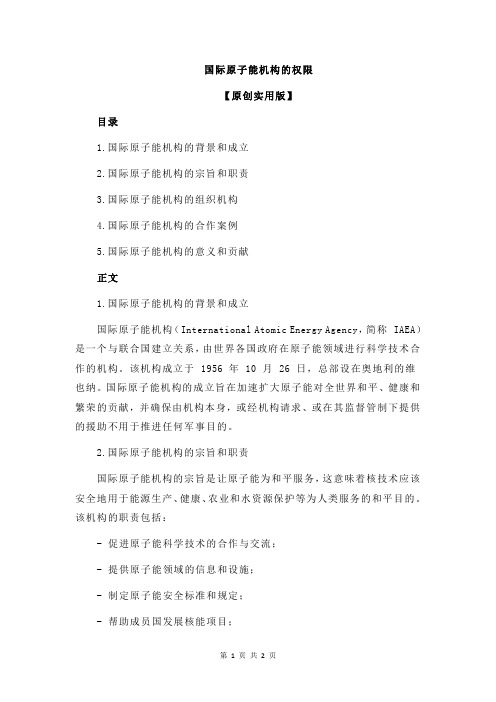
国际原子能机构的权限【原创实用版】目录1.国际原子能机构的背景和成立2.国际原子能机构的宗旨和职责3.国际原子能机构的组织机构4.国际原子能机构的合作案例5.国际原子能机构的意义和贡献正文1.国际原子能机构的背景和成立国际原子能机构(International Atomic Energy Agency,简称 IAEA)是一个与联合国建立关系,由世界各国政府在原子能领域进行科学技术合作的机构。
该机构成立于 1956 年 10 月 26 日,总部设在奥地利的维也纳。
国际原子能机构的成立旨在加速扩大原子能对全世界和平、健康和繁荣的贡献,并确保由机构本身,或经机构请求、或在其监督管制下提供的援助不用于推进任何军事目的。
2.国际原子能机构的宗旨和职责国际原子能机构的宗旨是让原子能为和平服务,这意味着核技术应该安全地用于能源生产、健康、农业和水资源保护等为人类服务的和平目的。
该机构的职责包括:- 促进原子能科学技术的合作与交流;- 提供原子能领域的信息和设施;- 制定原子能安全标准和规定;- 帮助成员国发展核能项目;- 监督和保障国际原子能合作项目的实施;- 应对核事故和辐射事故,确保核安全。
3.国际原子能机构的组织机构国际原子能机构的组织机构包括大会、理事会和秘书处。
大会由全体成员国代表组成,每年召开一次会议。
理事会由 15 名成员组成,其中 11 个成员由国际原子能机构大会指定,任期一年,其余 4 个成员由大会选出,任期两年。
秘书处为执行机构,由总干事领导,下设政策制定办公室、技术援助及合作司、核能和核安全司、行政管理司、研究和同位素司以及保障监督司。
4.国际原子能机构的合作案例国际原子能机构与世界各国进行广泛的合作,帮助成员国利用核技术解决能源、健康、农业和水资源等问题。
例如,在 2011 年 3 月 11 日日本福岛核电站事故发生后,日本政府向国际原子能机构寻求帮助。
国际原子能机构立即派出专家组前往日本,协助日本政府应对核事故,确保核安全。
大型科学实验室面向公众解说科学的一个样本——以欧洲核子研究中心的科学传播实践为中心

第39卷第3期Vol.39No.3科学与管理SCIENCE AND MANAGEMENT2019年6月Jun.2019大型科学实验室面向公众解说科学的一个样本——以欧洲核子研究中心的科学传播实践为中心吴燕(内蒙古师范大学科学技术史研究院,内蒙古呼和浩特010022)摘要:欧洲核子研究中心(Conseil Européen pour la Recherche Nucléaire,CERN)正式成立于1954年。
作为世界最大的粒子物理学实验室,CERN不仅致力于科学研究,也开展了多种形式的科学传播实践,从而形成了一套完整的体系与方法。
在所有的方法与理念中,有两点对于今日中国的科学传播尤其具有借鉴意义:一是在科普活动中也注重传递包括可持续发展等在内的价值与理念;二是在处理科学与社会的问题上注重增加信息的透明度。
关键词:欧洲核子研究中心;希格斯玻色子;科学传播;公众理解科学中图分类号:N4文献标识码:A DOI:10.3969/j.issn.1003-8256.2019.03.011开放科学(资源服务)标识码(OSID):0引言在科学技术日益走向大科学时代的今天,科学家与公众的关系也在发生变化。
科学家不再是掌握了知识的普及者,而负有义务向公众说明其研究的意义、它是否会带来负面影响,从而为其科学研究争取必要的经费资助。
科学作家吉姆·巴戈特在其著作《希格斯》中曾经提到,在1993年英国处于全球经济衰退的恢复期而几乎无力向欧洲核子研究中心(CERN)支付每年5500英镑的捐款时,英国科技大臣沃尔德格雷夫给物理学家们提出一项任务,即明确解释他们的科学研究到底是在做什么。
他最终收到117件参赛作品,“这本身也表明了物理学家所寻求的研究之重要性”。
而物理学家们的努力看来是有效的,因为在随后不管经济环境是否好转,英国政府都继续履行了它对CERN的承诺[1]。
通过面向公众讲解科学、增加研究工作的透明度,以谋求公众与政府的支持,欧洲科学家已在这方面有较多的尝试。
欧洲核子研究中心(CERN)
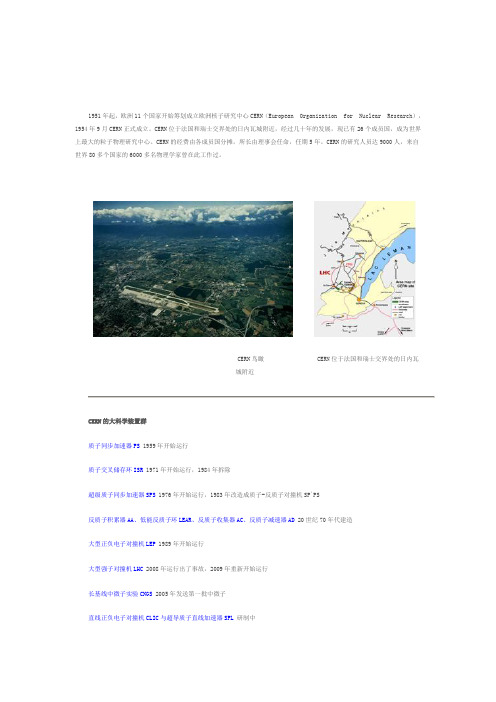
1951年起,欧洲11个国家开始筹划成立欧洲核子研究中心CERN(European Organization for Nuclear Research),1954年9月CERN正式成立。
CERN位于法国和瑞士交界处的日内瓦城附近,经过几十年的发展,现已有26个成员国,成为世界上最大的粒子物理研究中心。
CERN的经费由各成员国分摊,所长由理事会任命,任期5年。
CERN的研究人员达9000人,来自世界80多个国家的6000多名物理学家曾在此工作过。
CERN鸟瞰 CERN位于法国和瑞士交界处的日内瓦城附近CERN的大科学装置群质子同步加速器PS 1959年开始运行质子交叉储存环ISR 1971年开始运行,1984年拆除超级质子同步加速器SPS 1976年开始运行,1983年改造成质子-反质子对撞机SP`PS反质子积累器AA、低能反质子环LEAR、反质子收集器AC、反质子减速器AD 20世纪70年代建造大型正负电子对撞机LEP 1989年开始运行大型强子对撞机LHC 2008年运行出了事故,2009年重新开始运行长基线中微子实验CNGS 2005年发送第一批中微子直线正负电子对撞机CLIC与超导质子直线加速器SPL研制中(1)质子同步加速器PS建于20世纪50年代的质子同步加速器PS(Proton Synchrotron),是CERN加速器中最老和用途最广的加速器。
1959年调试完毕,从此连续运行。
它的直径为200米,最高能量达GeV,一度是世界上功率最大的加速器。
PS作适当修改后即可加速质子,又可加速电子或正电子。
PS隧道 PS示意图(2)质子交叉储存环ISR质子对撞机ISR(Intersecting Storage Rings)使用交叉储存环,其能量为2×31GeV,1971年投入运行,1984年拆除。
ISR的交叉储存环(3)超级质子同步加速器SPS超级质子同步加速器SPS(Super Proton Synchrotron)1971年开始建造,主加速器平均直径达2200米。
欧洲核子研究组织

欧洲核子研究组织欧洲核子研究组织(European Organization for Nuclear Research,简称CERN)是一个国际科研组织,成立于1954年,总部设在瑞士日内瓦附近。
CERN致力于研究基础粒子物理学,并进行相关实验和研究项目。
首先,CERN是一个拥有23个成员国的联合组织,成员国包括欧洲国家以及世界各地的其他国家。
这种国际合作的机制为CERN提供了充足的经费和资源支持,使其能够开展大规模的研究和实验项目。
CERN的成员国通过资金和科研资源的投入,共同研究和探索基础粒子物理学的领域。
其次,CERN拥有世界上最大的粒子加速器和探测器系统。
其中最著名的项目是大型强子对撞机(LHC),这是一座位于地下100米的环形加速器,周长27公里。
LHC的主要目标是加速两束质子到近光速,让它们相撞,并通过观察这些对撞事件来研究小型宇宙的行为。
CERN的研究成果对科学界产生了深远的影响。
例如,CERN在1989年发现了W和Z玻色子,这对于验证电弱统一理论做出了重要贡献,该理论是描述电磁力和弱力统一的重要理论。
此外,CERN还在2012年确认了希格斯玻色子的存在,这是标准模型中预言的最后一种基本粒子。
这项成果被誉为“21世纪的重大发现”。
此外,CERN也是一个重要的科学合作平台。
研究者们可以通过CERN的开放数据政策,获得LHC实验中产生的大量数据,并开展相关的研究。
这种开放政策有效地促进了全球科学界对基础粒子物理学的研究和发展。
总之,欧洲核子研究组织(CERN)作为一个国际科研组织,在基础粒子物理学领域发挥着重要的作用。
通过其成员国的联合和国际合作,CERN开展了一系列重要的研究和实验项目。
其研究成果对科学界产生了深远的影响,并为全球科学界提供了一个重要的合作平台。
原子能机构总部设在

原子能机构总部设在
国际原子能机构(IAEA)是一个多国组织,成立于1957年,总部设在奥地利维也纳。
该机构是联合国下属的一个独立机构,主要负责管理、监督和协调全球核能计划,以防止核武器的滥用和核污染,努力促进全球的和平与发展。
IAEA的宗旨是改善人类的健康和生活条件,促进经济和社会发展,控制和管理核能,以促进和平、经济和社会发展的安全、可靠和可持续的使用。
IAEA由35个成员国组成,致力于实现和平利用原子能的理想,使原子能提供安全、可靠和可持续的发电和用能服务。
IAEA在世界范围内开展了大量活动,积极参与核能技术的发展,促进国际和平、发展和安全,并在全球各地推动安全核能的发展。
IAEA的核安全和应急处理活动,包括管理和监测国际核材料贸易,核安全和应急处理技术咨询,以及在核设施安全、应急预案和核核安全培训和评估等领域的支持。
此外,IAEA参与专家组织研究,协助实施科学技术、能源和环境项目,完善全球核安全体系,发展核能技术,以及开展国际核联系与研究项目。
IAEA的总部位于奥地利维也纳,地处欧洲中心,地理位置优越,交通便利,是实现和平利用原子能的理想地。
在IAEA总部,每周都有会议举行,参与会议的有科学家、政府官员和学者等来自世界各地的代表。
作为一个国际机构,IAEA致力于实现和平利用原子能,促进全球的和平与发展,发展核能技术,推动全球核安全体系,并参与国际核联系与研究。
它的总部设在奥地利维也纳,是世界各国的政府和学者们开展国际核议题活动的主要平台。
欧洲核不扩散计划
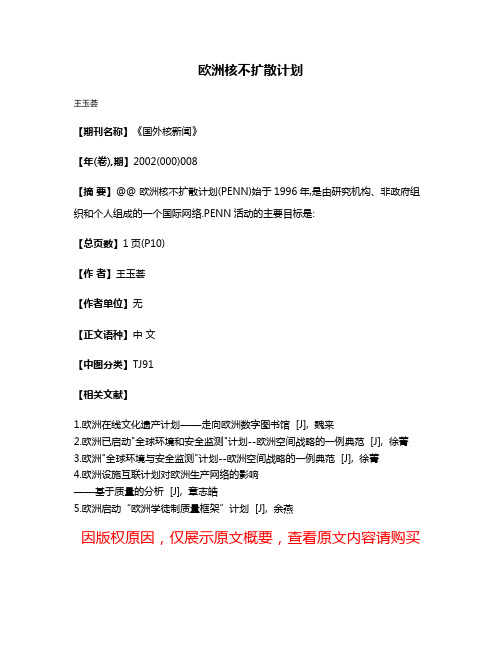
欧洲核不扩散计划
王玉荟
【期刊名称】《国外核新闻》
【年(卷),期】2002(000)008
【摘要】@@ 欧洲核不扩散计划(PENN)始于1996年,是由研究机构、非政府组织和个人组成的一个国际网络.PENN活动的主要目标是:
【总页数】1页(P10)
【作者】王玉荟
【作者单位】无
【正文语种】中文
【中图分类】TJ91
【相关文献】
1.欧洲在线文化遗产计划——走向欧洲数字图书馆 [J], 魏来
2.欧洲已启动"全球环境和安全监测"计划--欧洲空间战略的一例典范 [J], 徐菁
3.欧洲"全球环境与安全监测"计划--欧洲空间战略的一例典范 [J], 徐菁
4.欧洲设施互联计划对欧洲生产网络的影响
——基于质量的分析 [J], 章志皓
5.欧洲启动“欧洲学徒制质量框架”计划 [J], 余燕
因版权原因,仅展示原文概要,查看原文内容请购买。
欧洲理事会发布有关核废物管理的政策指令
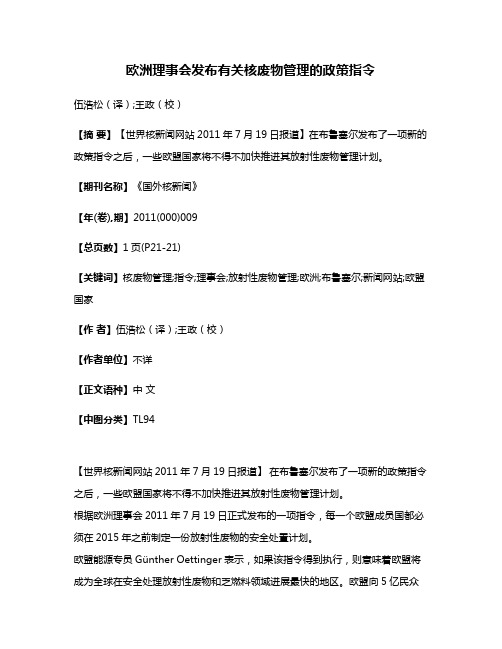
欧洲理事会发布有关核废物管理的政策指令伍浩松(译);王政(校)【摘要】【世界核新闻网站2011年7月19日报道】在布鲁塞尔发布了一项新的政策指令之后,一些欧盟国家将不得不加快推进其放射性废物管理计划。
【期刊名称】《国外核新闻》【年(卷),期】2011(000)009【总页数】1页(P21-21)【关键词】核废物管理;指令;理事会;放射性废物管理;欧洲;布鲁塞尔;新闻网站;欧盟国家【作者】伍浩松(译);王政(校)【作者单位】不详【正文语种】中文【中图分类】TL94【世界核新闻网站2011年7月19日报道】在布鲁塞尔发布了一项新的政策指令之后,一些欧盟国家将不得不加快推进其放射性废物管理计划。
根据欧洲理事会2011年7月19日正式发布的一项指令,每一个欧盟成员国都必须在2015年之前制定一份放射性废物的安全处置计划。
欧盟能源专员Günther Oettinger表示,如果该指令得到执行,则意味着欧盟将成为全球在安全处理放射性废物和乏燃料领域进展最快的地区。
欧盟向5亿民众宣告,“乏燃料与放射性废物的管理安全具有跨国意义,仅靠各国采取严格措施是无法得到保证的”。
各成员国即将制订的国家计划必须包括核废物的运输和“处置设施建设的具体时间表”。
尽管核废物管理的最终责任仍由各成员国承担,但这些国家计划将接受欧洲委员会的详细审查,并可能根据审查结果进行必要的修改。
预计这些国家计划,将在各成员国自愿参与的基础上,采取分阶段的方法逐步推进核废物的地质处理。
目前,乏燃料的最终处理有两种方案可供选择:一是将乏燃料作为核废料进行直接处置;二是对乏燃料进行后处理,提取出铀和钚进行循环使用,并将其他物质作为废物加以处置。
欧盟可能会允许各成员国之间出口乏燃料,这能够让欧盟各国联合建设一座共享的核废物处置设施。
如果需要将放射性废物出口到欧盟以外的国家,则该国必须拥有能够满足国际原子能机构(IAEA)相关要求的核废物处置设施。
【国际原子能机构成立时间与起因】促进世界和平利用原子能
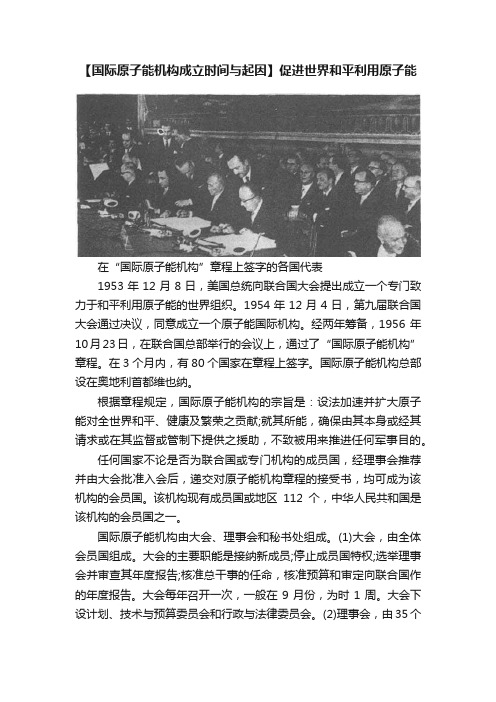
【国际原子能机构成立时间与起因】促进世界和平利用原子能在“国际原子能机构”章程上签字的各国代表1953年12月8日,美国总统向联合国大会提出成立一个专门致力于和平利用原子能的世界组织。
1954年12月4日,第九届联合国大会通过决议,同意成立一个原子能国际机构。
经两年筹备,1956年10月23日,在联合国总部举行的会议上,通过了“国际原子能机构”章程。
在3个月内,有80个国家在章程上签字。
国际原子能机构总部设在奥地利首都维也纳。
根据章程规定,国际原子能机构的宗旨是:设法加速并扩大原子能对全世界和平、健康及繁荣之贡献;就其所能,确保由其本身或经其请求或在其监督或管制下提供之援助,不致被用来推进任何军事目的。
任何国家不论是否为联合国或专门机构的成员国,经理事会推荐并由大会批准入会后,递交对原子能机构章程的接受书,均可成为该机构的会员国。
该机构现有成员国或地区112个,中华人民共和国是该机构的会员国之一。
国际原子能机构由大会、理事会和秘书处组成。
(1)大会,由全体会员国组成。
大会的主要职能是接纳新成员;停止成员国特权;选举理事会并审查其年度报告;核准总干事的任命,核准预算和审定向联合国作的年度报告。
大会每年召开一次,一般在9月份,为时1周。
大会下设计划、技术与预算委员会和行政与法律委员会。
(2)理事会,由35个理事国组成。
理事国分为“被指定的理事国”和“选举的理事国”。
前者由核技术最先进的国家和各地区中在技术方面先进的国家担任,任期1年;后者按地区均衡分配原则选举产生,任期2年。
多年来,“被指定的理事国”一直由法国、美国、苏联、英国、日本、加拿大、巴西、澳大利亚、印度等国担任。
1984年6月,中国成为“被指定的理事国”。
理事会大约每3个月举行一次会议。
理事会下设行政预算委员会、技术援助委员会、科技顾问委员会和保障委员会等4个咨询委员会。
(3)秘书处,是执行机关,下设有政策制订办公室及技术援助和出版部、技术业务部、行政管理部、研究和同位素部、保障和监督部。
国际原子能机构是什么
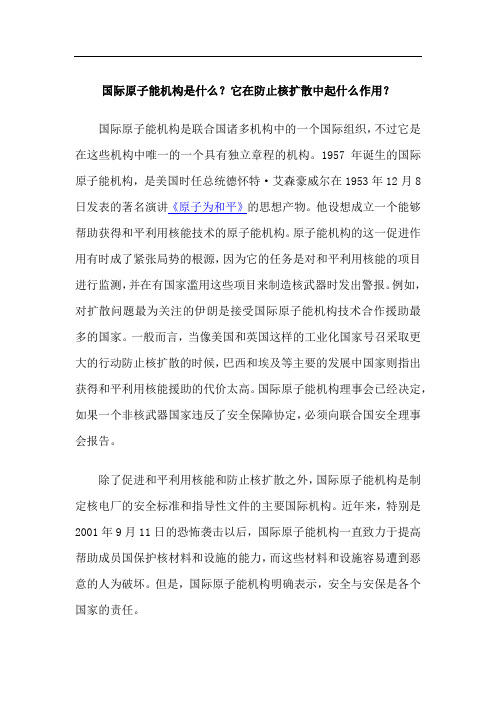
国际原子能机构是什么?它在防止核扩散中起什么作用?
国际原子能机构是联合国诸多机构中的一个国际组织,不过它是在这些机构中唯一的一个具有独立章程的机构。
1957年诞生的国际原子能机构,是美国时任总统德怀特·艾森豪威尔在1953年12月8日发表的著名演讲《原子为和平》的思想产物。
他设想成立一个能够帮助获得和平利用核能技术的原子能机构。
原子能机构的这一促进作用有时成了紧张局势的根源,因为它的任务是对和平利用核能的项目进行监测,并在有国家滥用这些项目来制造核武器时发出警报。
例如,对扩散问题最为关注的伊朗是接受国际原子能机构技术合作援助最多的国家。
一般而言,当像美国和英国这样的工业化国家号召采取更大的行动防止核扩散的时候,巴西和埃及等主要的发展中国家则指出获得和平利用核能援助的代价太高。
国际原子能机构理事会已经决定,如果一个非核武器国家违反了安全保障协定,必须向联合国安全理事会报告。
除了促进和平利用核能和防止核扩散之外,国际原子能机构是制定核电厂的安全标准和指导性文件的主要国际机构。
近年来,特别是2001年9月11日的恐怖袭击以后,国际原子能机构一直致力于提高帮助成员国保护核材料和设施的能力,而这些材料和设施容易遭到恶意的人为破坏。
但是,国际原子能机构明确表示,安全与安保是各个国家的责任。
- 1、下载文档前请自行甄别文档内容的完整性,平台不提供额外的编辑、内容补充、找答案等附加服务。
- 2、"仅部分预览"的文档,不可在线预览部分如存在完整性等问题,可反馈申请退款(可完整预览的文档不适用该条件!)。
- 3、如文档侵犯您的权益,请联系客服反馈,我们会尽快为您处理(人工客服工作时间:9:00-18:30)。
EUROPEAN ORGANIZATION FOR NUCLEAR RESEARCHCERN–PPE/97–149November28,1997A Search for OscillationThe CHORUS CollaborationE.Eskut,A.Kayis,G.Oneng¨u tC¸ukurova University,Adana,TurkeyR.van Dantzig,M.de Jong,J.Konijn,O.Melzer,R.G.C.Oldeman,C.A.F.J.van der Poel,J.W.E.Uiterwijk,J.L.VisschersNIKHEF,Amsterdam,The NetherlandsA.S.Ayan,E.Pesen,M.Serin-Zeyrek,R.Sever,P.Tolun,M.T.ZeyrekMETU,Ankara,TurkeyN.Armenise,F.Cassol,M.G.Catanesi,M.T.Muciaccia,E.Radicioni,S.Simone,L.VivoloUniversit`a di Bari and INFN,Bari,ItalyA.B¨u lte,P.Lendermann,A.Meyer-Sievers,T.Patzak,K.WinterHumboldt Universit¨a t,Berlin,GermanyP.Annis,M.Gruw´e,C.Mommaert,M.Vander Donckt,B.Van de Vyver,P.Vilain,G.Wilquet Inter-University Institute for High Energies(ULB-VUB),Brussels,BelgiumP.Righini,B.SaittaUniversit`a di Cagliari and INFN,Cagliari,ItalyE.Di Capua,C.Luppi,P.ZucchelliUniversit`a di Ferrara and INFN,Ferrara,ItalyY.Ishii,T.Kawamura,M.Kazuno,S.Ogawa,H.ShibuyaToho University,Funabashi,JapanR.Beyer,J.Brunner,D.Cussans,J.P.Fabre,R.Ferreira,W.Flegel,R.Gurin,M.Litmaath,L.Ludovici,D.Macina,R.Meijer Drees,H.Meinhard,P.Migliozzi,E.Niu,H.Øver˙a s,J.Panman, I.M.Papadopoulos,F.Riccardi,S.Ricciardi,A.Rozanov,D.Saltzberg,R.Santacesaria,G.Stefanini,R.Tsenov,Ch.Weinheimer,H.WongCERN,Geneva,SwitzerlandJ.Goldberg,K.HoepfnerTechnion,Haifa,IsraelM.ChikawaKinki University,Higashiosaka,JapanE.Arik,I.Birol,A.A.MailovBogazici University,Istanbul,TurkeyC.H.Hahn,H.I.Jang,I.G.Park,M.S.Park,J.S.Song,C.S.YoonGyeongsang National University,Jinju,KoreaK.Kodama,hidaAichi University of Education,Kariya,JapanS.Aoki,T.HaraKobe University,Kobe,JapanG.Brooijmans,D.Favart,G.Gr´e goire,J.H´e rin,V.LemaˆitreUniversit´e Catholique de Louvain,Louvain-la-Neuve,BelgiumA.Artamonov,P.Gorbunov,V.Khovansky,V.Shamanov,V.SmirnitskyInstitute for Theoretical and Experimental Physics,Moscow,Russian FederationD.Bonek¨a mper,D.Frekers,D.Rondeshagen,T.WolffWestf¨a lische Wilhelms-Universit¨a t,M¨u nster,GermanyK.Hoshino,M.Kobayashi,Y.Kotaka,T.Kozaki,M.Miyanishi,M.Nakamura,K.Nakazawa,T.Nakano,K.Niu,K.Niwa,Y.Obayashi,O.Sato,T.ToshitoNagoya University,Nagoya,JapanS.Buontempo,A.Cocco,N.D’Ambrosio,G.De Lellis,A.Ereditato,G.Fiorillo,F.Garufi,F.Marchetti-Stasi,M.Messina,V.Palladino,S.Sorrentino,P.StrolinUniversit`a Federico II and INFN,Naples,ItalyK.Nakamura,T.Okusawa,T.YoshidaOsaka City University,Osaka,JapanA.Capone,D.De Pedis,S.Di Liberto,U.Dore,P.F.Loverre,A.Maslennikov,M.A.Mazzoni,F.Meddi,G.PireddaUniversit`a La Sapienza and INFN,Rome,ItalyA.di Bartolomeo,C.Bozza,G.Grella,G.Iovane,G.Romano,G.RosaUniversit`a di Salerno and INFN,Salerno,ItalyY.Sato,I.TezukaUtsunomiya University,Utsunomiya,JapanAbstractCHORUS is an experiment searching for oscillation in the CERN wide band neutrino beam with a hybrid setup consisting of a nuclear emulsion target followed by electronic detectors.The experiment has been taking data from1994through1997.A subset of the neutrino interactions collected in1994and1995have been analyzed,looking for charged current interactions where the lepton decays to.In a sample of31,423 charged current interactions,no candidates were found.For large values,a limit on the mixing angle of at C.L.can be set,thus improving the previous best result.Submitted to Physics Letters.Now at College de France,Paris,France.Supported by German Bundesministerium f¨u r Bildung und Forschung under contract numbers056BU11P and057MS12P.Supported by Regione autonoma della Sardegna,Italy.Now at CERN,Geneva,Switzerland.Fonds pour la Formation a la Recherche dans l’Industrie et dans l’Agriculture.Interuniversitair Instituut voor Kernwetenschappen.Nationaal Fonds voor Wetenschappelijk Onderzoek.Fonds National de la Recherche Scientifique.Now at DESY,Hamburg,Germany.On leave of absence from LIP,Lisbon.CASPUR,Rome,Italy.On leave of absence from INFN Sezione di Roma,Rome,Italy.Now at Universit´e de Gen`e ve,Geneva,Switzerland.Now at University of Washington,Seattle,USA.Now at CPPM CNRS-IN2P3,Marseille,France.Now at U.C.L.A.,Los Angeles,USA.On leave of absence from Sofia University,Bulgaria,with support from the Bogazici University,Centre for Turkish-Balkan Physics Re-search and Applications.Now at University of Mainz,Mainz,Germany.Now at Academia Sinica,Taipei,Taiwan.Now at the Changwon Nat.Univ.,Changwon,Korea.Supported by the Korea Scince and Engineering Foundation,and the Ministry of Education through Research Fund(BSRI-97-2407), Republic of Korea.Institut Interuniversitaire des Science Nucl´e aires.Supported by a grant from Deutsche Forschungs Gemeinschaft.Now at Gifu University,Gifu,Japan.Now at Universit`a La Sapienza and INFN,Rome,Italy.1IntroductionCHORUS is an experiment designed to search foroscillation through the observation of charged current interactions,followed by the decay of the lepton.The experiment can probe neu-trino masses difference above few eV(). Massive neutrinos in this range have been proposed as candidates for the hot component of dark matter in the universe[1],and the oscillation search is fur-ther motivated if one assumes a hierarchical pattern of neutrino masses.The experiment is performed in the CERN Wide-Band Neutrino Beam,which contains mainly with a contamination from well below the level of sensitiv-ity that can be reached in this experiment.Neutrino interactions occur in a target of nuclearemulsion,whose exceptional spatial resolution(below one micrometer)and hit density(grains/along the track)allow a three dimensional“visual”reconstruc-tion of the trajectories of the lepton and its decay prod-ucts.The experiment is sensitive to most of the decay channels of the;in this paper however we report on the results obtained with a subsample where we con-fined ourselves to the decay search.The detection of the decay topology in the nuclear emulsion, together with the reconstruction of the event kinemat-ics in the electronic detectors,make CHORUS an es-sentially background free appearance experiment.2The Experimental setup2.1The neutrino beamThe CERN wide band neutrino beam(WBB)con-tains dominantly muon neutrinos from and de-cay,with a contamination of5%,a contami-nation at a level of.The estimated background[2] is of the order of charged current inter-actions per charged current interaction,hence neg-ligible.The component of the beam has an average energy of.2.2The apparatusThe short decay length of the(on aver-age,assuming that the have the same energyspec-Figure1:General layout of the detector.trum as the beam)and the large statistics needed to improve the best existing result[3]have guided the de-sign of the apparatus,which is described in ref.[4].The hybrid setup,shown in Fig.1,is composed of an emul-sion target,a scintillatingfiber tracker system,trigger hodoscopes,a magnetic spectrometer,a lead-scintillator calorimeter and a muon spectrometer.The emulsion target has a mass of and a sur-face area of.It consists of four stacks of36plates each.Each plate has two thick lay-ers of nuclear emulsion on both sides of a thick plastic base.Downstream of each emulsion stack there are three sets of interface emulsion sheets of the same lateral di-mensions as the emulsion target.Each interface emul-sion sheet consists of a acrylic base coated,on both sides,with a thick emulsion layer.They are placed between each emulsion stack and the follow-ingfiber tracker module as shown in Fig.2.Scintillatingfiber trackers locate the trajectories of charged particles produced in the neutrino interaction. The trajectories of these particles are extrapolated to the downstream face of the emulsion stack with the help of the interface emulsion sheets.Thefiber tracker resolu-tion on lateral position and direction is and ,respectively.Downstream of the target region,a magnetic spec-trometer allows the reconstruction of the charge and mo-mentum of charged particles.The spectrometer consists of an air-core magnet of hexagonal shape and three scin-tillatingfiber trackers,one in front and two behind the air-core magnet,which record the charged particles’tra-jectory and deflection.A lead scintillatingfiber calorimeter following the spectrometer measures the energy and direction of the hadronic showers and allows neutral particles detection.The calorimeter is followed by a muon spectrom-eter which identifies muons and measures their charge and momentum.It is composed of magnetized iron disks and tracking devices.A momentum resolution of is achieved above by magneticfield deflection. By range measurement,a resolution is obtained be-low.Figure2:Layout of an emulsion stack and associated fiber trackers.1Table1:Current status of the CHORUS search. Emulsion triggersCharged current interactions expectedEvents with one identified muon and vertex predicted in emulsionsEvents withEvents scanned so farEvents within thefiducial cutsEvents with a vertex found in the emulsion3The Data CollectionThe detector has been exposed to the WBB from 1994to1997.After afirst run(1994–95),the target emulsion was replaced and the exposed emulsion devel-oped.During this period CHORUS collected approxi-mately969,000triggers,corresponding toprotons on target.On the basis of neutrinoflux esti-mate,trigger efficiency,cross section,dead-time correc-tion and target mass,about charged current interactions are expected to have occurred in the emul-sion target.Of these events have been recon-structed in the electronic detectors with an identified negative muon and an interaction vertex in the emulsion. 4The search analysis4.1PrinciplesThe search for decays starts from the reconstructed events recorded in the electronic de-tectors.The event selection,described later,provides us with a set of events with a reconstructed muon track and a prediction for the trajectory of the muon through the interface emulsion sheets.The muon track is located in the interface emulsion sheets using automatic tech-niques and followed into the emulsion target in order to locate the plate where the interaction had occurred. Automatic criteria are then applied to select candidate events with the one-prong decay topology we are look-ing for.If the automatic decay search does not reject the event,computer assisted eye scan of the vertex plate (and downstream plates if necessary)is performed,in order to assess the presence of a decay topology.If a candidate is found,all tracks are measured in the emulsion and connected to those found in the elec-tronic detectors;in addition,the event kinematics can be reconstructed.4.2Event selectionOnly events with one negative muon,of momentum,have been considered.The momen-tum cut reduces the number of events to be further an-alyzed to177,827.Since muons from decay have a lower momentum,on average,than those produced in charged current interactions,this selection would reject only a small fraction of genuine interactions(15%in the case that have the same energy spectrum asthe beam),while reducing the charged current in-teractions that would have to be scanned to71%of the total.So far,only79,500events of the177,827have been scanned.Since the scanning procedure requires the ap-plication offiducial cuts on the angle and position ofthe muon track,the sample is further reduced to67,813 events.The number of events at each stage of the analy-sis are summarized in Table1.4.3The vertex locationThe emulsion scanning procedure is fully automated using computer controlled microscopes equipped with CCD cameras and fast processors:this is thefirst time that fully automatic scanning is achieved.The processor, which is called track-selector[5],is capable of identify-ing the tracks inside the emulsion and measuring their parameters on-line.In the scanning procedure,these sys-tems are used to locate the negative muon track in the interface emulsion sheets,and to follow it inside the tar-get,plate by plate,until it disappears in two consecu-tive plates.Thefirst plate where the track disappears is called the vertex plate.The vertex location procedure, called scan-back,has been successful for charged current events.Once the vertex plate has been located,the decay search,described in more detail in the following section,is performed.4.4The decay search procedureAn event with a lepton is identified by the pres-ence of a change of direction(kink)of the track due to the semileptonic decay,whilea muon pointing to the vertex is the leading muon of acharged current event.We consider as candidates events satisfying the following criteria:-a decay signature(kink)along the track;-no other charged leptons at the primary vertex;-the muon transverse momentum,with respectto the candidate direction,is larger than.2P t ≈P µ.∆θ [GeV/c ]e v e n t sdataMC ντ500100015000.10.20.30.40.50.60.70.80.91Figure 3:Transverse momentum distribution in long de-cay path events of data and of MC simulation.-the kink plate is located within 5plates down-stream of the vertex plate (corresponding to a max-imum decay path length of ).The cut on eliminates the decays,keeps the loss of efficiency for events small and at the same time discards the large majority of coming from interactions at the level of automatic measurements.Figure 3shows the distribution for the collected data sample compared with the Monte Carlo distribution ex-pected for events.Due to the ongoing development of the automatic scanning devices and procedures,dif-ferent kink search algorithms have been applied to the analysis of 1994and 1995data in order to optimize speed and efficiency of the decay search procedure.4.4.1The 1994data analysisThe decay search is performed following two differ-ent procedures,which are applied concurrently on eachevent located.i)short decay path search .This search is designedto detect decays in the vertex plate.Two different ap-proaches are followed according to the number of tracksreconstructed by the track-selector at the upstream faceof the plate following the vertex plate.If there is at leastone track matched with the tracker predictions (Fig.4,topol-ogy a.),the impact parameter is evaluated as theminimum distance between the muon track and any othertrack of the event (Fig.5).Only events which show alarge impact parameter,i.e.bigger than ac-cording to the longitudinal position inside the plate,arevisually inspected and re-measured with semi-automatictechniques.For the events with no matched hadrons,digital images of the microscope fields over the whole vertex plate depth are recorded,and the search for a kink continues off-line (video image analysis).Topology a.Topology c.Figure 4:Search for kink topologies,as described in thetext.ii)long decay path search .This procedure is de-signed to detect decays downstream of the vertex plate.The scan-back procedure follows the muon track from one plate of the target to the next one,implicitly assum-ing the track straightness.A ‘long’decay path can thus be detected in two ways,according to its kink angle:-If the decay angle is larger than the scan-back an-gular tolerance (large angle kinks),the scan-back procedure stops and the kink plate is assumed to be the vertex plate (Fig.4,topology b.).Since no other emulsion tracks can be matched to the fiber trackers predictions to apply the short decay path search,the video image analysis is undertaken.-If the kink angle is smaller than the tolerances of the scan-back (Fig.4,topology c.),the ver-tex plate is indeed the interaction plate and decays can be detected by measuring a track direction in the plate immediately downstream of the vertex plate which is not compatible with measurements in the other detectors (emulsion plates,interface emulsions,fiber tracker).If the measured trans-verse momentum is larger than ,the complete event is scanned by eye in five plates downstream of the vertex plate.4.4.2The 1995data analysis Currently only the long decay path search has been performed on 1995data,with the recently developed “parent track”search technique applied for large angle3dataMC ντImpact parameter [µm ] e v e n t s200040006000051015202530Figure 5:Impact parameter distributions in the search of short decay path decays of data and of MC simulation.kink detection.As explained in the 1994long decay path search,whenever a large angle decay is found,the kink plate is assumed to be the vertex plate (Fig.4,topology b ).In the ‘parent track’search technique the upstream part of the vertex plate is scanned in order to check the possibility of associating a track with the muon.If the minimal distance between a track and the muon is less than ,this track will be considered its ‘parent’.Checks are made to ensure that the parent track is not a passing-through track accidentally associated to themuon.If a parent track is found,the event is scanned by eye.5Analysis and Result A total of 31,423muonic events have been analyzed as described above,and no tau decays have been found.By evaluating the detection efficiencythis negative result is used to exclude a significant regionof the oscillation parameter space.5.1Oscillation sensitivityIn the two flavour mixing scheme,the result can beexpressed as an exclusion plot in the parameter space().The oscillation probability dependson the number of observed and events.The total number of expected charged currentinteractions is given byand the total number of observed interactions with a muonic decay is whereandis the incident neutrino energy;is the neutrino path-length to the emulsion tar-get;is the mixing angle;;is a constant factor (identical for and in-teractions)that takes into account the mass of thedetector and the integrated neutrino flux;is the energy distribution;is the path distribution at a given neu-trino energy value;and are the charged current anddifferential cross sections;and are the energy dependent accep-tance and reconstruction efficiencies;is the energy dependent kink detection effi-ciency;is the branching ratio (,[6]).Since we have observed zero candidate events,we can express the upper limit on accord-ing to:(1)In the above formula the numerical factor takes into ac-count the total systematic error ()following the pre-scriptions given in [12].For large values,and so the previous formula can be simplified into (2)whereis the neutrino energy weighted cross section ratio[13].A value of has been used;it takes into account quasi elastic interactions,resonance production and deep inelastic reactions.is the cross section weighted acceptance ratio of and interactions,its value has been evaluated to be .is the average kink detection efficiency for the accepted events.Because of the different pro-cedures,its value is for the 1994datasample and in 1995where only the long decay path search has been performed.4CHORUS 97CHARM IICDHSE531CCFR Figure 6:Present result and previous limits from CCFR [8],CDHS [9],CHARM II [10]and E531[3].A graphical representation of the oscillation param-eter region excluded with the current data is shown inFig.6.Maximum mixing between and is excludedat C.L.if .5.2The identification efficiency.The computation of the exclusion plot in the oscilla-tion parameter space requires the knowledge of the ac-ceptance and reconstruction efficiencies and and of the kink detection efficiency.These efficiencies have been estimated by Monte Carlo simulation of the detector and of the scanning procedure.The scanning procedure and henceand have evolved in the course of the analysis.Several approaches have been used in computing the above quantities so we can es-timate a systematic error of 7%.The kink detection efficiency has been evaluated by Monte Carlo simulation and has been averaged over the different kink search procedures described previously.The relative systematic error has been evaluated to be .Since we expect production in induced inter-actions[7]we can check experimentally the estimated kink finding efficiency on one-prong muonic charm decaysThese events have two muons of opposite charge in the final state (dimuons )and –except for the particle charges –the topology of the muonic charm decay is the same as that of the decay.A sample of positive muons from dimuon events has been scanned to estimate the kink de-tection capability.A first sample consisting of 10dimuon events with a decay kink was selected by eye and the automatic kink search applied.The kink finding ef-ficiency of the automatic procedure is consistent with our estimates by Monte Carlo simulation.In an enlarged sample of 17events,including three prong decays,the distribution of flight path length is in good agreement with that obtained from the Monte Carlo simulation of the automatic scanning procedure.Although the number of events is too low to draw quantitative conclusions,we can take these results as a qualitative check of the simu-lation of the automatic scanning procedure.5.3Backgrounds estimateThe main sources of potential background are charm production and the contamination of the beam.We expect less than charm events in the current sample from the anti-neutrino components of the beam:followed byin which the ()escapes detection or is mis-identified.Taking into account cross sections,branching ratioand kink detection efficiency,we expect the current sam-ple to contain less than 0.01events due to direct con-tamination of the beam[2].6Conclusions We have presented limits on oscillationparameters based on the muonic decay channel of the using a fraction of the data collected by the CHORUS experiment.The limit on for large val-ues is at 90%C.L.,and im-proves the best previous result.A search for hadronic decays using the sample of events without a muon is in progress and results from partial statistics have been reported in [11].By improving the efficiencies,by in-creasing the number of decay channels searched for and by enlarging the search to the complete set of data we expect to reach the design sensitivity of the ex-periment.If no candidates are found this corresponds toa limit of for large values.AcknowledgmentsWe gratefully acknowledge the help and support of our numerous technical collaborators who contributedto the detector construction,operation,emulsion pour-ing,development and scanning.We thank the neutrino beam staff for the competent assistance ensuring the ex-cellent performance of the facility.The accumulation ofa large data sample in this experiment has been made possible also thanks to the efforts of the crew operating5the CERN PS and SPS.The general technical support from PPE,ECP and CN divisions is warmly acknowl-edged.The experiment has been made possible by grants from our funding agencies:the Institut Interuniversitaire des Sciences Nucl´e aires and the Interuniversitair Insti-tuut voor Kernwetenschappen(Belgium),The Israel Sci-ence foundation(grant328/94)and the Technion Vice President Fund for the Promotion of Research(Israel), CERN(Geneva,Switzerland),the German Bundesmin-isterium f¨u r Bildung und Forschung(Germany),the In-stitute of Theoretical and Experimental Physics(Moscow, Russia),the Istituto Nazionale di Fisica Nucleare(Italy), the Japan Private School Promotion Foundation and Japan Society for the Promotion of Science(Japan),the Korea Science and Engineering Foundation and the Ministry of Education(Republic of Korea),the Foundation for Fundamental Research on Matter FOM and the National Scientific Research Organization NWO(The Netherlands) and the Scientific and Technical Research Council of Turkey(Turkey).We gratefully acknowledge their support. References[1]Ya.B.Zel’dovic and I.D.Novikov,Relativistic As-trophysics,Nauka,Moscow,1967.H.Harari,Phys.Lett.B216(1989)413.J.Ellis,J.L.Lopez and D.V.Nanopoulos,Phys.Lett.B292(1992)189.H.Fritzsch and D.Holtmannsp tter,Phys.Lett.B338(1994)290.[2]B.Van der Vyver,Nucl.Instr.and Meth.A385(1997)91.M.C.Gonzalez-Garcia and J.J.Gomez-Cadenas,Phys.Rev.D55(1997)1297.[3]hida et al.,Phys.Rev.Lett.57(1986)2897.[4]E.Eskut et al.,CHORUS Collaboration,CERN-PPE/97–033,Nucl.Instr.and Meth.(in print). [5]S.Aoki et al.,Nucl.Instr.and Meth.B51(1990)466.[6]Particle Data Group,Phys.Rev.D541(1996).[7]H.Abramowicz et al.,CDHS Collaboration,ZPhys.C15(1982)19.S.A.Rabinowitz et al.,CCFR Collaboration,Phys.Rev.Lett.70(1993)134.P.Vilain et al.,CHARM II Collaboration,Z.Phys.C(to be published).[8]K.S.McFarland et al.,Phys.Rev.Lett.75,3993(1995).[9]F.Dydak et al.CDHS collaboration,Phys.Lett.B134(1984)103.[10]M.Gruw´e et al.,CHARMII collaboration,Phys.Lett.B309(1993)463.[11]CHORUS Collaboration,Proceedings of theXVIII International Symposium on Lepton andPhoton Interactions,Hamburg,1997,contributedpaper LP–189.[12]R.D.Cousins and V.L.Highland,Nucl.Instr.andMeth.A320(1992)331.[13]C.Jarlskog C.H.Albright,Nucl.Phys.B84,467-492,1975.6。
